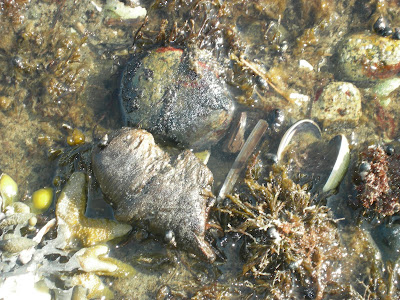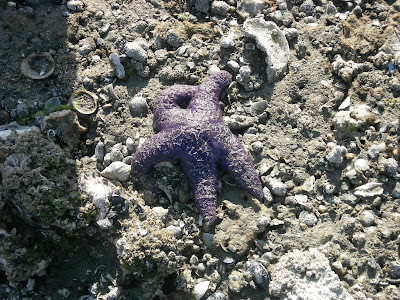On Sunday Roger & I went for a walk to Myrtle Rocks at low tide (around 5:30 PM). What an (educational) adventure! (If you click on the pictures, they should open so you can see the big version.)
What, in the picture, looks like sand is mostly rocks and some sand heavily littered with mussel, clam & oyster shells that the seagulls have dropped on the rocks to break them open. There are also lots of huge unopened oysters covered with barnacles. We found an oyster fused with a clam shell; from what we could tell, the oyster was still inside. I think I found two oysters fused together, both open, long ago eaten--is there such a thing as conjoined oysters?
 Unfortunately, according to a sign warning against collecting the oysters at Myrtle Rocks, if we try to collect and eat the oysters, we risk paralytic shellfish poisoning. I guess if Roger and I want oysters, we'll have to go collect them from one of the many oyster leases around here. After all, I've learned how to shuck oysters (and didn't damage myself in the process), but that's another story entirely.
Unfortunately, according to a sign warning against collecting the oysters at Myrtle Rocks, if we try to collect and eat the oysters, we risk paralytic shellfish poisoning. I guess if Roger and I want oysters, we'll have to go collect them from one of the many oyster leases around here. After all, I've learned how to shuck oysters (and didn't damage myself in the process), but that's another story entirely.**Correction: Silly me--the only people who can gather oysters from oyster leases are the people who hold the leases. We'd have to get licenses to gather oysters from public beaches.
In the first tidal pools we stopped to observe, we saw plenty of movement--seaweed, debris in the current, and little animals moving around. Mostly the little animals were crabs. The largest one we saw was about the size of a tooney. Can you find the crab in this picture?

And how many can you find in this picture?
 I imagine the big crabs we get served in restaurants would be a little frightening to encounter (pinch, pinch), but these tiny guys were cute and fun.
I imagine the big crabs we get served in restaurants would be a little frightening to encounter (pinch, pinch), but these tiny guys were cute and fun. Our next encounter was the aforementioned variety of huge oysters, apparently still cozy in their mollusky homes. And then there were the sand dollars, all bleached white or yellow-turning-white. (I've always wanted to find sand dollars on a beach, ever since I saw one at school when I was about ten.) At first I was afraid that if I took some, I'd be taking something alive, but then we realized that the white ones weren't alive, so we collected a few of them, took them home, washed them off with the hose before we even rinsed our shoes, and left them outside to finish bleaching.
Our next encounter was the aforementioned variety of huge oysters, apparently still cozy in their mollusky homes. And then there were the sand dollars, all bleached white or yellow-turning-white. (I've always wanted to find sand dollars on a beach, ever since I saw one at school when I was about ten.) At first I was afraid that if I took some, I'd be taking something alive, but then we realized that the white ones weren't alive, so we collected a few of them, took them home, washed them off with the hose before we even rinsed our shoes, and left them outside to finish bleaching.And here's how we came to understand that the white and yellow sand dollars weren't alive:

See the purple one? That's what a live sand dollar looks like. And once we saw one, we saw them everywhere. If you touch them, their shells are rough going in one direction and smooth (almost velvety) going the other direction. And they shimmer as their cilia move, which my camera still pictures didn't capture very well.


This is how they live, in huge masses burrowed in the sand.
I also learned that clams spurt spouts of water up from where they hide in the sand. My attempts to catch that in action didn't turn out so well, but it was fun watching the vast landscape of barnacled rocks, sand and shells spitting up playful little geysers.
And the last of the pictures are also of a purple sea beast: starfish. Many of them were hiding under rocks, but a couple brave ones were out basking in the sun.




Oh, and about those crab pictures:







